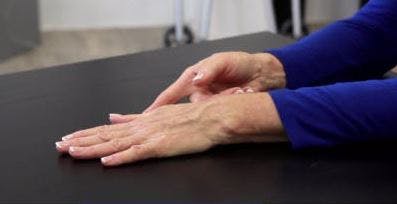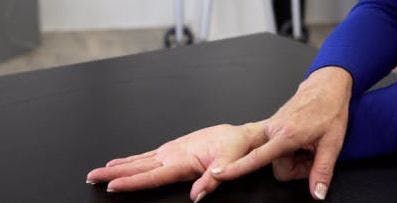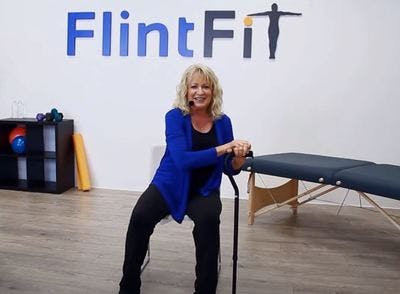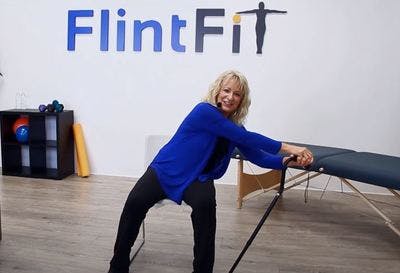Hemiplegia results from a neurologic condition that includes damaged brain cells on one side of the brain. Medical conditions that damage the nervous system such as stroke, brain injury, or cerebral palsy commonly result in hemiplegia. Often, this affects the way people move, walk, or care for themselves.
Individuals with hemiplegia often rely on assistive devices, such as walkers or wheelchairs, and the help of caregivers to carry out daily tasks. Fortunately, regaining better movement quality is often possible thanks to the nervous system’s ability to rewire itself.
To help you understand the symptoms and treatment methods for hemiplegia, this guide will discuss:
Hemiplegia Definition
Hemiplegia is weakness or paralysis on one side of the body resulting from damage to the nervous system. It can cause difficulty moving one’s face, arm, and leg on either the right or left side of the body.
Types of Hemiplegia
One of the most common causes of hemiplegia is stroke. When a stroke occurs, the supply of blood in the brain is compromised and causes damage to nerve cells in a specific region of the brain.
Other neurological conditions that can cause hemiplegia are brain injury, spinal cord injury, and cerebral palsy. Hemiplegia in individuals with cerebral palsy is congenital, meaning that it is caused by damage to the brain before, during, or shortly after birth.
Listed below are the possible types of hemiplegia:
Contralateral hemiplegia
The brain is divided into two hemispheres. The right hemisphere controls movement on the left side of the body, and the left hemisphere controls movement on the right side of the body. Contralateral hemiplegia refers to paralysis on the side of the body that’s opposite (contralateral) to the side where the brain damage occurred.
Right hemiplegia refers to paralyzed muscles on the right side of the body following injury to the left hemisphere of the brain. Left hemiplegia refers to paralyzed muscles on the left side of the body after right hemisphere injury.
Spinal hemiplegia (ipsilateral)
Unlike the brain, the spinal cord controls movement to the same side (ipsilateral) of the body. After spinal cord injury, right hemiplegia describes paralysis on the right side of the body after injury to the right side of the spinal cord, whereas left hemiplegia reflects paralysis on the left side of the body after injury to the left side of the spinal cord. Brown-Sequard syndrome is another term referring to this relatively rare condition.
Spastic hemiplegia
Spastic hemiplegia refers to a type of hemiplegia that is common with cerebral palsy. Weakness or paralysis on the side of the body opposite to the hemisphere of the brain injured before, during, or shortly after birth is called spastic hemiplegia. It is the most common type of cerebral palsy, where the arm is usually more affected than the leg.
The term ‘spastic’ refers to spasticity experienced by the person with cerebral palsy. Spasticity includes stiff, involuntarily-contracted muscles. Individuals with spastic hemiplegia display stiff movements while individuals with flaccid hemiplegia experience loose, floppy muscles on their affected side.
Facial hemiplegia
Facial hemiplegia is paralyzed or weak muscles on one side of the face. It can be the only symptom of nerve damage or occur in conjunction with hemiplegia elsewhere in the body.
One of the hallmark signs of a stroke is facial drooping on one side of the face. Facial hemiplegia can be temporary and go away once the stroke has been treated and normal blood flow in the brain is restored.
Hemiplegia Symptoms and Signs
Because hemiplegia is a neurologic condition, the symptoms vary based on the characteristics of the injury, its location, and size. For example, a spinal cord injury only impairs movement below the level of injury, while a brain injury can impair movement anywhere on the affected side, ranging from the face to the arm to the leg.
Every neurologic injury is unique, and therefore, every individual experiences hemiplegia slightly differently. Some common signs and symptoms include:
- Paralysis of the arm, leg, and/or lower face on the affected side
- Difficulty with walking and balance
- Loose, floppy muscles (flaccidity) on the affected side
- Stiff, rigid muscles (spasticity) on the affected side
- Delay in developmental milestones for children with spastic hemiplegia
Hemiplegia is a secondary effect of a primary neurologic injury. Individuals with a primary injury involving the brain may also experience other secondary symptoms such as:
- Sensory loss (numbness, “pins and needle” sensations)
- Visual disturbances
- Difficulty with speech
- Seizures
- Neglect and learned nonuse of the affected side
Hemiplegia does not cause these additional symptoms. They are complications of the primary neurologic injury.
Hemiplegia Treatment
Treatment for hemiplegia occurs in two phases. First, the primary neurologic injury is treated, if possible. For example, when a stroke occurs, initial treatment focuses on stopping the stroke and restoring normal blood flow in the brain. This can include administration of anti-coagulants or even stroke surgery.
The second phase of hemiplegia treatment involves stimulating the nervous system to rewire itself. The brain or spinal cord can strengthen and reorganize neural pathways through neuroplasticity.
After one area of the brain is damaged, neuroplasticity causes unaffected parts of the brain to grow and develop control of the muscles originally controlled by the damaged parts of the brain. For spinal cord injuries, neuroplasticity reorganizes neural pathways in the spine. This “rewiring” is possible when the spinal cord is not completely severed. See our article on complete spinal cord injury for more details.
Neuroplasticity is enhanced by experience and repetition. When movement is practiced, the nervous system is stimulated to create and strengthen new neural pathways for that movement. Through experience and repetition, individuals with hemiplegia are able to regain movement on the paralyzed side. This is why exercise is essential for hemiplegia treatment (more on this later).
Not all individuals can regain functional movement, but all can stimulate their nervous system. Regardless of an individual’s prognosis, every neurologic injury is unique, so even when the odds are unfavorable, stimulating the nervous system with movement (passive or active) is worthwhile. No one can predict the true outcome of any single neurologic injury. Therefore, the only way to know how much movement a person can recover is to pursue rehabilitation and see what happens.
Rehabilitation Methods for Hemiplegia
What rehabilitation methods help improve hemiplegia? Each rehabilitation method described below will stimulate neuroplasticity, potentially improving hemiplegia.
Rehabilitation exercise
Rehabilitation exercises are designed to help rewire the brain through repetition. When therapeutic movements are practiced with good form, it stimulates neuroplasticity and encourages better movement patterns.
Passive exercise
Individuals with hemiplegia may be unable to move their limb through its full range of motion. With help from another individual, your limb can be moved through its full range of motion passively. Your joint moves even though your targeted muscle group has not actively contracted to cause that movement. This is called passive exercise.
Even though your muscles are not contracting to generate this movement, passive movement stimulates the brain and sparks neuroplasticity, particularly when attention is paid to the movement. For example, if an individual performs passive exercise while watching television, it won’t have as much of the desired effect. In addition, passive exercise provides gentle stretching to the affected limbs, which helps restore the use of those muscles.
Physical therapy
Physical therapists specialize in restoring movement in the body. Individuals with hemiplegia benefit from working with a physical therapist to practice rehabilitation exercises tailored to their unique needs.
Occupational therapy
Occupational therapists help you find meaningful or fun ways to engage with movements that will lead to neuroplasticity. Because your brain requires many repetitions of movements to rewire itself, making an exercise engaging successfully is the key to recovery. When an activity is meaningful or fun, it will be repeated.
Often OTs use activities of daily living to stimulate neuroplasticity and improve a person’s function. Occupational therapists can teach individuals how to use adaptive devices to accomplish daily activities.
Assistive devices
Individuals with hemiplegia are at a greater risk of falling, particularly if leg function and balance are impaired. It’s always a good idea to consult with a physical and/or occupational therapist to get recommendations when using assistive devices for walking or activities of daily living. There is a wide range of devices for enhancing mobility or increasing independence with activities of daily living. So, be sure to ask a therapist if there is equipment you can use to make your life easier.
Mental practice
Mental practice, or mental imagery, involves visualizing yourself practicing a movement that you want to improve. Studies have shown that visualizing movement sparks changes in the parts of the brain that control movement such as the motor and premotor areas in the cortex of the brain.
Mental practice can be done anytime and anywhere, even from your bed. The accessibility of this therapy makes it a great fit for individuals with hemiplegia. For best results, individuals can mentally rehearse their rehabilitation exercises before actually performing them. Studies have found that combining mental practice with physical practice leads to better results than physical practice alone.
Electrical stimulation
When hemiplegia makes voluntary movement difficult, electrical stimulation can cause contractions in the affected muscles. Electricity is applied to the affected muscles through pads affixed to the skin. Never attempt to do electrical stimulation by yourself without first consulting with a therapist and receiving training.
Muscle contractions from electrical stimulation cause a contraction of the affected muscles, reminding those tissues how to respond to neuronal inputs. As with all hemiplegia treatments, use this therapy in conjunction with rehabilitation exercises for the best results.
Electrical acupuncture
Acupuncture is an alternative treatment that involves inserting thin needles into specific “acupoints” on the body. Sometimes electrical stimulation can be applied to these needles after they are inserted; and sometimes electrical stimulation pads can be affixed to the specific acupoint instead of a needle.
One study found that electrical acupuncture helped improve hemiplegia when using the latter technique (applying e-stim through pads affixed to specific acupoints) combined with traditional rehabilitation exercises.
Sensory retraining
After a stroke, some individuals with hemiplegia experience sensory changes like numbness or “pins-and-needles” sensations. Sensory nerve fibers provide the brain with important information and can help the brain reorganize. There are many sensory receptors in the nervous system, and a rehabilitation technique called sensory retraining offers ways to stimulate all these sensory receptors, which stimulate the brain. This therapy improves the brain’s ability to process sensation while stimulating neuroplasticity.
One important sensory receptor in the body is our receptor for joint position. Proprioception is the body’s ability to determine where its joints are in space without visual cues. Studies indicate stimulating proprioception improves rehabilitation from stroke.
Modified constraint-induced movement therapy
Modified constraint-induced movement therapy (mCIMT) involves restraining the non-affected limb to encourage use of the affected side. For example, an oven mitt can be placed on the non-affected hand to encourage use of the affected hand.
mCIMT is potentially frustrating to a person with hemiplegia. Therefore, it’s important to do this therapy to the point of challenge, but not frustration.
One study found that mCIMT led to better results than traditional therapy alone. It’s worth noting that each individual participated in nearly 6 hours of therapy per day, which is twice the amount of therapy given during inpatient rehabilitation. These results affirm the common understanding that the amount (or dose) of exercise increases one’s rehabilitation potential.
Exercises for Hemiplegia
As you can see, every treatment for hemiplegia involves some form of exercise because it’s the key to improving movement after neurologic injury. Here are some types of hemiplegia exercises your therapist may recommend:
Passive exercises
Passive exercises can be accomplished in a variety of ways. For hand exercises, individuals can use their non-affected hand to assist their affected hand through the exercise. However, heavier limbs like the leg require help from a therapist or caregiver to passively perform these exercises.


One example of a passive exercise for the hand is “palm up and down.” During this exercise, you place your affected hand on a table and then use your non-affected hand to turn your palm up and down. Pay close attention to the movement to maximize neuroplasticity.
See more hand therapy exercises »
Strengthening exercises
Individuals with hemiplegia are at greater risk of muscle atrophy (when the muscles shrink and waste away) due to nonuse. Therefore, it’s helpful to perform weight-bearing exercises that strengthen the muscles on the affected side.


One example is the “cane lean” exercise. Start by placing your affected hand on a cane and then place your non-affected hand on top for stability. Then, gently and safely lean into the affected side. This weight bearing helps stimulate the affected side.
Stretching exercises
Individuals with hemiplegia need to perform stretching exercises to prevent tightening of their joints, especially when spasticity is involved. For the upper arm, include a forearm stretch and wrist stretch.

During the forearm stretch, place your hands in your lap and then interlace your fingers. Then bend your wrist to stretch your affected arm palm-side up.

For the wrist stretch, keep your fingers interlaced and then gently bend your affected wrist. It’s ok to feel a gentle pulling sensation, but never stretch to the point of sharp pain.
If you’re looking for suitable exercises for hemiplegia, your therapist is a great resource. They know how to choose suitable exercises that target your unique needs.
You can also browse through our library of rehabilitation exercises and adapt them for hemiplegia by practicing them passively. It’s a good idea to have a therapist assign you some exercises and then practice those specific exercises daily at home. Remember that repetition is required for neuroplasticity.
Improving Movement with Hemiplegia
Hemiplegia involves paralysis on one side of the body, often after injury to the brain or spinal cord. Treatment includes rewiring the brain through repetitive exercises.
While exercise is one of the best rehabilitation methods, you can enhance your results by combining traditional therapy with other modalities such as electrical stimulation and mental practice.
Every neurologic injury is unique, which means that every individual can benefit from a unique therapy plan. Work closely with your therapists and try to be as consistent as possible with your exercises. This will help maximize the chances of regaining movement with hemiplegia.
The post Understanding Hemiplegia: Paralysis of One Side of the Body appeared first on Flint Rehab.



